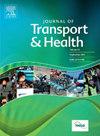Necessary, but not quite sufficient? Public opinion and reported behaviour following the reduction of speed limits in Scottish rural settlements
IF 3.3
3区 工程技术
Q2 PUBLIC, ENVIRONMENTAL & OCCUPATIONAL HEALTH
引用次数: 0
Abstract
Introduction
20 mph speed limits were implemented in place of 30mph limits across most settlements in the Scottish Borders Council area (UK) between October 2020 and January 2021. Previous quantitative studies show that speeds driven reduce and less people are injured, and of those who are most have less severe injuries than if struck by a vehicle in a 30mph speed limit. Speed reduction, therefore, is an important public health intervention.
Methods
This paper reports the findings of 25 structured interviews with adult residents of the Scottish Borders who had experience of living there before, during and after the change, contributing qualitative evidence as to what people feel and say regarding this intervention.
Results
The results revealed a generally positive opinion of the 20mph limits. Many respondents noted a reduction in driving speed, although not necessarily to the posted speed limit. There were perceptions of small safety improvements, particularly for pedestrians and cyclists, although some remained concerned about speeding drivers.
Conclusions
The 20 mph speed limits have fostered a greater sense of equity amongst different road users and have largely been accepted as the ‘new norm’. Yet, 20mph probably remains insufficient on its own in addressing the externalities of motorised traffic among those outside of vehicles and the persistent fears generated by motor traffic.
必要,但还不够充分?在苏格兰农村定居点降低限速后,公众舆论和报道的行为
在2020年10月至2021年1月期间,苏格兰边境委员会地区(英国)的大多数定居点实施了20英里/小时的限速,取代了30英里/小时的限速。先前的定量研究表明,开车速度降低,受伤人数减少,而受伤人数最多的人受伤程度要比以每小时30英里的速度被一辆车撞到要轻。因此,减速是一项重要的公共卫生干预措施。本文报告了对苏格兰边境的成年居民进行的25次结构化访谈的结果,这些居民在变化之前,期间和之后都有过在那里生活的经历,为人们对这种干预的感受和说法提供了定性证据。结果结果显示,人们普遍对20英里/小时的限速持积极态度。许多受访者指出,驾驶速度有所降低,尽管不一定达到规定的速度限制。有人认为,安全方面有了小幅改善,尤其是行人和骑自行车的人,尽管一些人仍然担心超速驾驶。20英里每小时的限速在不同的道路使用者之间培养了更大的公平感,并在很大程度上被接受为“新规范”。然而,20英里每小时的速度本身可能还不足以解决机动车交通的外部性,以及机动车交通产生的持续恐惧。
本文章由计算机程序翻译,如有差异,请以英文原文为准。
求助全文
约1分钟内获得全文
求助全文

 求助内容:
求助内容: 应助结果提醒方式:
应助结果提醒方式:


